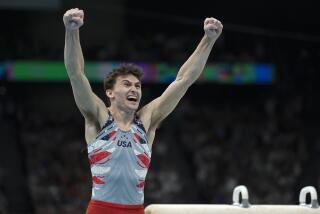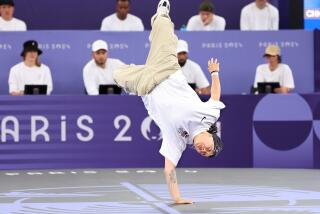Don’t call it ballroom dancing
- Share via
MIAMI -- Evgeny Dyachenko and Inna Ivanenko spend hours in the gym lifting weights. Five, six days a week they practice at the ballet bar to keep their legs and backs strong, squeezing in yoga or Pilates classes to help with their stretching.
Their schedule may sound like the regimen of a tennis champion or an NFL player, but Dyachenko, 25, and Ivanenko, 34, a married couple originally from Russia, are training for what could be the next big Olympic sport: ballroom dancing.
“People think that you can learn how to be like beautiful in one week, which is not realistic,” said Ivanenko, who rehearses for at least six hours a day. “It takes years and years and years.”
The timing has never been better for ballroom dancing, which has only recently caught Americans’ fancy.
“Dancing with the Stars” was ranked in the top 5 shows of 2007 for both its weekly broadcasts, according to Nielsen Media Research ratings. Even the show’s accomplished athletes visibly struggle with the routines.
“If you look at the young people today competing, right now they can’t drink. They can’t smoke,” said Didio Barrera, the features editor for Dance Beat, a magazine about ballroom dancing. “They cannot go to bed late or you will have a bad performance. It’s to that level where you cannot afford to have a rough night or just go to the club.”
But is it a sport?
The World Sports Federation thinks so. So does the International Olympic Committee. In fact, it was because of the IOC that ballroom dancing is now known as DanceSport.
“Anybody who has done it knows it’s a sport because it’s hard,” said James Fraser, International DanceSport Federation Presidium member. The point of the name change, he said, was “to direct the whole consciousness of what we’re doing to a sport, rather than an art.”
There’s no doubt it can be physically taxing. The muscle exertion and breathing rates of competitors in a two-minute ballroom dance were equal to those of cyclists, swimmers and an Olympic 800-meter runner over the same period of time, according to a 1986 study at the University of Freiburg, Germany.
In 2002, DanceSport submitted a request to be considered for admission to the Olympics. The IOC considers several factors in adding a sport, including the sport’s history and tradition, popularity and cost. DanceSport will not be included in the 2012 Olympic Games, but could be added in 2016.
The IOC has asked DanceSport to increase its spectatorship and television viewership, both of which the dancing community has been doing steadily.
More to Read
Go beyond the scoreboard
Get the latest on L.A.'s teams in the daily Sports Report newsletter.
You may occasionally receive promotional content from the Los Angeles Times.






